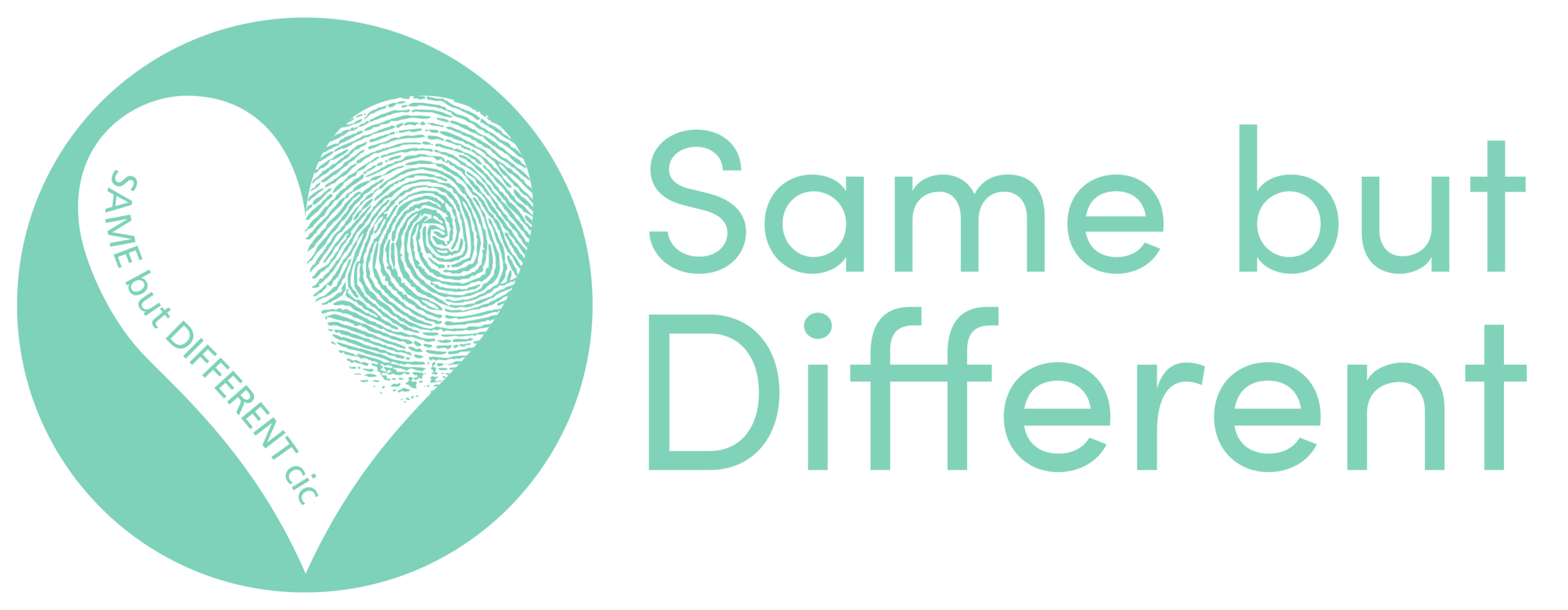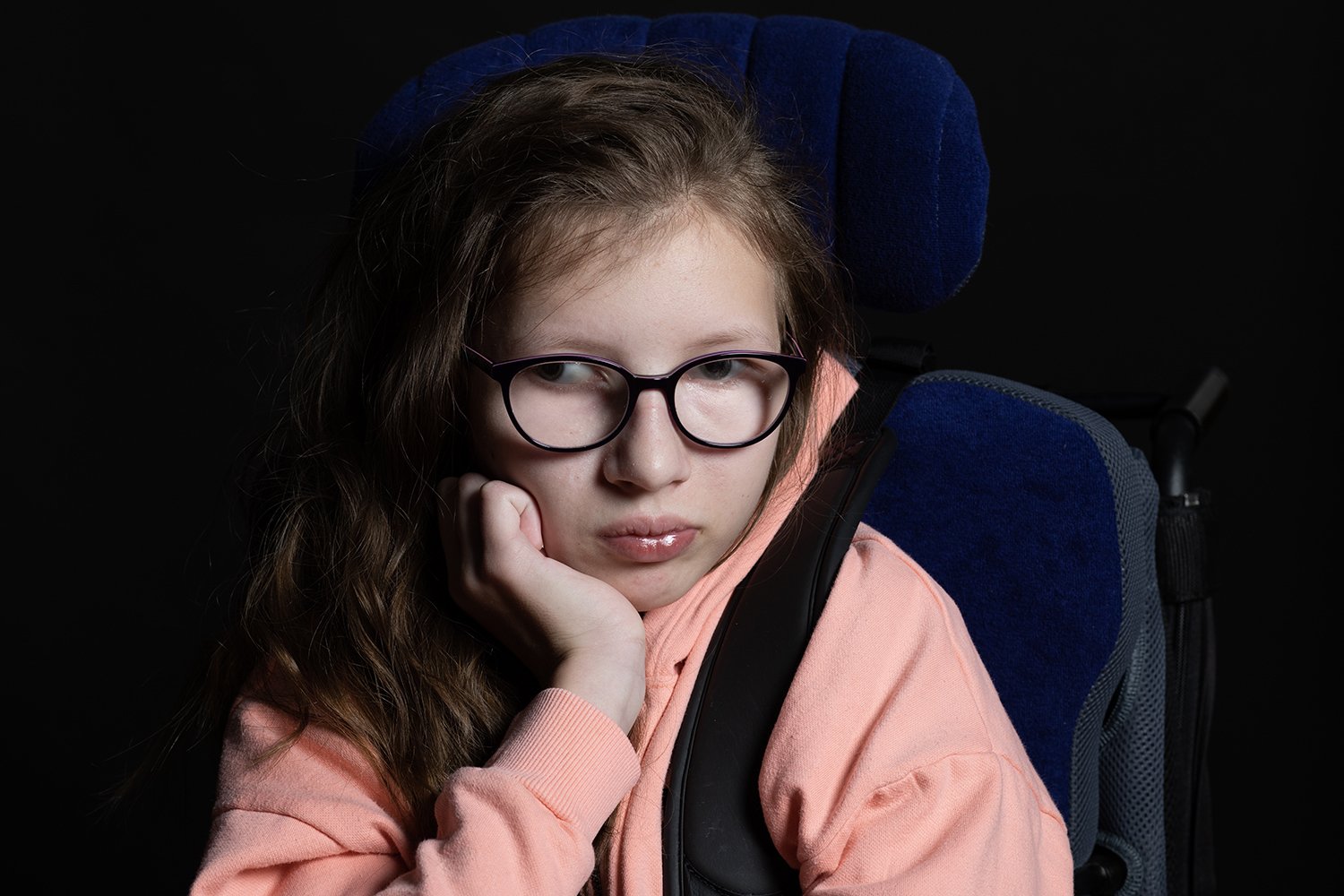LILY & WILLOW
Willow laughing in her 2022 photoshoot - All photographs by Ceridwen Hughes
Sisters Lily (14) and Willow (9) live with their parents in Suffolk, UK. The girls have mitochondrial disease, specifically, Lily has Leigh’s Disease and Willow has mitochondrial complex 1 deficiency both of which are genetic conditions. Their parents Michelle and Jamie each carry a copy of the mutation in their genes which was passed onto the girls. “Jamie and I didn't know we were carriers for it. We both have mutations, different mutations within the same protein. The mitochondria are in every cell of the body.
They basically produce the energy to keep everything working properly. It can affect the heart, brain, muscles, eyes, hearing, stomach or kidneys. The girls’ condition specifically targets the brain. So obviously, we don't know what will happen in the future. It tends to be after a period of illness that regressions can happen because it's a progressive disease. Depending on where the mitochondria lose function, that will be the area that is affected. They have yearly heart checks and now we're about to start having X-rays on their hips because of Lily’s hip dislocation that required surgery.”
Lily looking into the camera
Lily hasn’t been able to walk or fully stand by herself since she was two and a half years old. However, up until recently, she could do a standing transfer with support. This changed after Lily’s last operation on her hip in 2021. Her parents noticed that Lily wasn’t quite right “It came on very quickly. We just kind of noticed her leaning over and that hip area just didn't seem right. She's got such a high pain threshold and has pain daily, so she just said it didn't hurt. I was concerned and I called the physio who managed to pass on the referral fast to get a consultant’s appointment.” After seeing the consultant Lily was referred to an orthopaedic surgeon who advised that an operation was needed to correct the hip. It wasn’t fully dislocated but the muscle spasms Lily has were pulling out the hip joint. “It was about a six-and-a-half-hour surgery. They had to break the hip, then put the joint back in place and plate it all back together. Whilst this operation was underway, they also did muscle lengthening because her muscles are really tight and she couldn’t straighten that leg either.” Lily was in a full cast for six weeks.
“They suspected it was a mitochondrial disease but they didn't give us any information. They just said it's a bit like Parkinson's, it will be a very up-and-down road. I asked if it was going to kill her? How bad is this? They answered that they couldn’t tell us really and they didn’t know what was going to happen. So, then the dreaded Google searches started, it said it could be this or this, which were both mitochondrial things. It said that it was mostly fatal about two and a half years after diagnosis. I was like, ‘well, she's had this from birth, and she's two and a half now. Does that mean she could pass away at any minute? Or is it we've just been diagnosed now? So, it could be two and a half years from now?’.”
Michelle enjoyed a normal pregnancy with Lily and it wasn’t until she was 2 years old that her mum started noticing little things. The first of which was her hand was constantly in a fist and she was unable to jump, even on a trampoline her movements were different to other children. It was at her two-year check-up that it was noticed she was delayed slightly. The health visitor referred Lily to a local consultant thinking she may have cerebral palsy. After several appointments, it was ruled out. “They said that she doesn't actually fit the pattern of cerebral palsy so they ran a CT scan and they found lesions on her brain.” An MRI scan was then undertaken, and the family had an appointment to talk through Lily’s results.
Lily has Leigh’s Disease
The family were left worried and still confused about what was happening with Lily. Still desperate to find out more they stumbled across the Lily Foundation and got in contact. They had more hope from the Lily Foundation. They discovered children had died around age 5 but Lily’s symptoms were completely different and not at the same stage. “I couldn't really believe that she was going to get to five. We were having meetings because she couldn’t walk, then she was using splints on her legs to help her stability and a walking frame. She needed what is now an EHCP to get the help required at school, which we started to complete when she was three, I couldn’t even think of a time when she was going to start school, it all seemed very unreal. When she started school and had her fifth birthday, I was like, wow, okay, let's just keep on going. Then we get closer to the end of primary school, and I am like ‘is this really going to happen? She's going to get secondary school?’ Now we've got a teenager.”
The chance of conceiving another child with the same syndrome as Lily was 1 in 4. Michelle and Jamie knew they wanted a second child and fell pregnant with Willow. They decided not to test during the pregnancy using CVS or Amniocentesis as the risk to the pregnancy was too high for them. “It was just kind of like well, we know what we're dealing with, hopefully, it would be the same. We didn't really want to go down the IVF route because we might end up with twins, or we might end up with a different condition. So, we let it all come about naturally. We had asked for testing when Willow was born so we could get her on riboflavin early, which is basically all Lily had taken for several years because they found that riboflavin was the most beneficial.
Because the genetic team knew where to look, their initial check was for the mutation that Lily's got, and it was confirmed that Willow does have the same mutations. This meant she started on riboflavin at four months old in the hope that it will limit any damage to the brain. We've recently had an MRI because she was old enough to do that without going under a general anaesthetic. She has got lesions on her brain and she still has issues relating to her Mitochondrial disease, but she hasn't had any kind of regression as Lily has, so hers is just classed as a complex one deficiency at the moment.”
Willow and mum Michelle
Juggling appointments for the family could be tricky but luckily the girls have both got the same physio, OT, and paediatric consultant locally. They always attended at the same time which meant only one trip. Recently, however, they are trying to keep some appointments separate. Michelle explained, “Lily's more aware now so they've been having the appointments separately so that she doesn't worry about anything that's going on with Willow as much. The only appointment that we have together now is the Oxford one, which we just have yearly.”
Both girls enjoy going to the Unique Feet group and have recently performed with them as part of Rarefest22. “Lily was part of Unique Feet from the very beginning. She enjoys it and obviously has a closer bond with the children from the first group.” As a support group, mum Michelle finds it helpful too. “In Unique Feet, everyone's got different diseases there but there's always someone that I can contact for advice; from help with forms to practical advice on buying a suitable wheelchair-accessible vehicle. It’s very reassuring knowing others are there to talk to as well as the practical side.” The family are lucky and have a good support network around them, from Unique Feet, the Lily Foundation, CRDN and also from East Anglia’s Children’s Hospice that provides respite at the moment with Lily and will continue to do so in the future with both girls. Both girls have benefitted from hydrotherapy recently and Lily is looking forward to her first overnight stay in the Easter holidays. Michelle is lucky that her mum also helps out when she can.
Speaking of the future Michelle says sometimes it is too difficult to think about and for her, it’s easier to try not to think of it. However, when a family in one of her support groups suffers the loss of their child it brings her back to reality, but Michelle is realistic and hopeful at the same time “If I think about it too much I’d never ever get on with my life at all. This is a progressive condition. So Lily and Willow are not going to get any better. I do kind of think about it and then put it to the back of my mind. Through the Lily Foundation and meeting other parents that have gone through that grief, you know, one day you're going to join that club, but who knows when?
Fingers crossed? I don't know anyone that's had it as young as Lily and as old, but we know a lady, who was diagnosed at seven and she's now in her 30s, you know, maybe it could be possible for our girls too.”
For now both girls are doing well, Lily zooms around in her power chair and Willow is a ball of energy. The family are living each day as it comes, living in the moment and in hope.
Lily in 2022
FIND OUT MORE
What is mitochondrial disorder?
Mitochondrial disease, or mitochondrial disorder, refers to a group of disorders that affect the mitochondria, which are tiny compartments that are present in almost every cell of the body. The mitochondria’s main function is to produce energy. More mitochondria are needed to make more energy, particularly in high-energy demand organs such as the heart, muscles, and brain. When the number or function of mitochondria in the cell are disrupted, less energy is produced and organ dysfunction results.
To learn more about Mitochondrial Disorder, click here.
Source: https://www.chop.edu/conditions-diseases/mitochondrial-disease
UNIQUE FEET
Unique Feet brings together kids and families who understand each other’s shared challenges and difficulties but who also know how important it is to celebrate their achievements.
Often that understanding enables the UF ‘gang’ to raise one another up to help achieve hopes and dreams that might be so much more difficult to achieve alone.
To find out more about Unique Feet and how they can support you, click here.
Read the Impact Report and hear from families about what this community means to them here.
The Lily Foundation
The Lily Foundation is the UK's leading mitochondrial disease charity and the largest charitable funder of mitochondrial research in Europe. Our mission is to improve the lives of people affected by mitochondrial diseases, while working towards a future where mitochondrial diseases can be effectively treated or cured.
To find out more about Unique Feet and how they can support you, click here.
CAMBRIDGE RARE DISEASE NETWORK
Cambridge Rare Disease Network is a platform for change. It is the infrastructure that unites patients, advocates, experts and leaders to address the challenges faced by people affected by rare diseases. By sharing knowledge and experience, and working together, the journey towards better diagnosis, treatment and support for patients and their families is smoother and more certain.
To find out more about Cambridge Rare Disease Network and how they can support you, click here.
Source: https://www.camraredisease.org
East Anglia's Children's Hospices
East Anglia's Children's Hospices support families and care for children and young people with life-threatening conditions across Cambridgeshire, Essex, Norfolk and Suffolk.
To find out more about East Anglia's Children's Hospices and how they can support you, click here.
Source: https://www.each.org.uk
You can read about some of the other people taking part in the Rare Project by clicking here.
Don't forget to visit and 'Like' our Facebook page too so we can keep you up to date with our new rare stories by clicking here.









